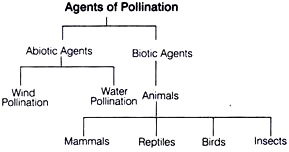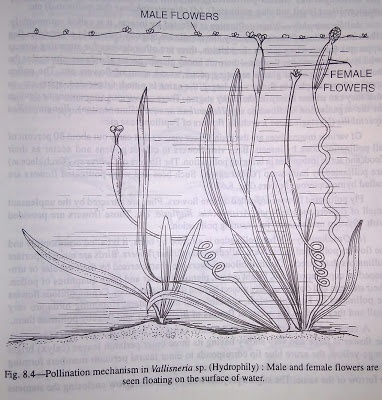Pollination in angiosperms has been grouped into two main categories according to the agents involved.

The structures of flowers and pollens differ in all types of flowers pollinated by different agents.
Wind.
Pollination caused by wind is called anemophily. These type of flowers are found in the members of the families Gramineae, Betulaceae, etc. Small and inconspicuous flowers characterize them. The pollen grains are small, smooth-walled, light, dry, and produced in large quantities to increase the chances of pollination. The stigma is bush-like and protrudes beyond the floral envelops to catch pollen grains in the air easily.
Water.
Pollination affected by water is known as hydrophily. Hydrophilous flowers are common in submerged aquatic monocotyledonous plants such as Hydrilla, Najas, etc. and are small and inconspicuous. The floral parts are absent or so reduced. These flowers are grouped into:
- Ephydrophily– pollination takes place on the surface of the water. During maturity, the staminate part is detached from the male plant, thus floating on water. The pistillate flower, which rises above the water because it has an elongated stalk which is spirally coiled, receives the staminate part. This leads to pollination after which the female flower is dragged below the water by recoiling of the stalk.
- Hyphydrophily– pollination takes place entirely underwater e.g., Najas, etc. the pollen is usually long and lacks exile. The pollen has almost similar gravity to that of water; hence, they can freely float in the water at any given depth. The flowers stigma is usually long, and it coils around the pollen when they come in contact.

Animals.
Pollination through animals is called zoophily. Zoophilous flowers are subdivided into:
- Entomophily– this is the pollination affected by insects. The entomophilous flowers are attractive due to the brightly colored corolla. They contain nectar glands located at the base of both petals and sepals for the secretion of nectar and sweet scent which attracts insects. These flowers contain larger pollen grains. These flowers are mostly visited by bees looking for nectar for the production of honey.
- Omithophily– this is pollination affected by birds. Omithophilous flowers are characterized by their cup-shaped form, plenty of nectar, large quantities of pollen, and bright color. The stamens and carpels protrude beyond the perianth lobes. The stigma projects freely enclosing the stamens and style to catch pollen easily.
- Malacophily– pollination by other animals, for instance, slugs, snails, etc. larger trees are often visited by squirrels which help in pollination.
- Chiropteriphily– this is pollination by bats which has been recorded mostly in the tropics. Such flowers have long stalks and are mostly in clusters, or singly away from leaves and branches. Bats visit them to suck nectar with their long tongues. In the process, pollen is transferred from the anthers to the stigma.